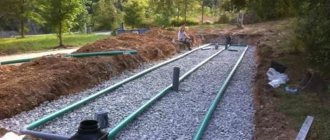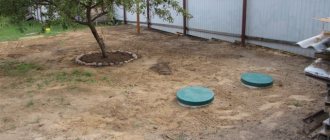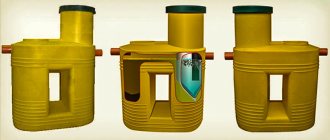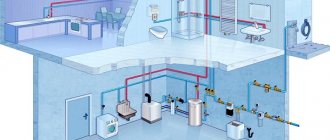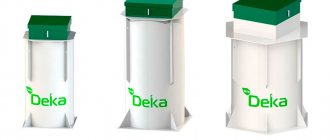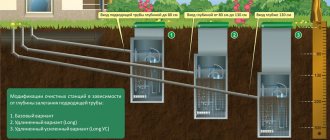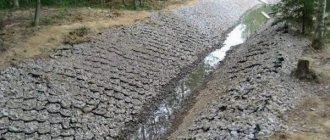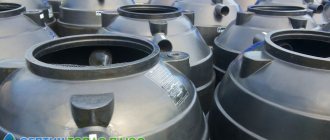23.11.2018
When installing a septic tank, experts always report that the key to a long service life is proper care. To avoid having to call specialists in an emergency, you need to remember to check the functionality of the device. Equipment in a private house allows you to get all the advantages of the city's civilization. Other sewerage equipment options will be less effective. They often give off an unpleasant odor. Therefore, a septic tank in a private house is an ideal solution. One of the disadvantages of using them is the need to independently ensure that drains are cleaned and waste is pumped out on time.
Rules that will help extend the life of use
In order for the device to function for the maximum period, it is necessary to check in time how well it performs its functions. The purification mechanism will not be brought to an emergency state if the owner follows these rules:
- ♻️ Do not use chlorine or other bleaches as they destroy the container. Septic tanks work thanks to the activity of bacteria that can process waste. Chlorine negatively affects their lives. The death of organisms will cause the tank to become clogged faster than the remaining bacteria can cope with the breakdown of debris. If for some reason you had to use chlorine-containing substances, then you need to introduce new bacteria into the tank the next day.
- ♻️ Do not allow waste from vegetables, machine oil, plastic bags, etc. to get into the tanks.
- ♻️ Regularly call a cesspool machine to carry out cleaning. Actions can be carried out by the owner independently. To prevent unpleasant aromas from causing discomfort, you should use a bandage on your nose. By using reagents, the amount of time spent on purification will be reduced. They are poured directly into the system. But regular cleaning will be more effective.
- ♻️ If there is a power outage, the system should not be used. This will cause clogging of the device and will definitely require calling a specialist.
- ♻️ Once every 6 months, the tank must be cleaned of sediment and silt. This will prevent the equipment from clogging. This frequency is not always relevant. When the device is not used for a long time, cleaning may occur much less frequently. The owner checks the degree of contamination.
Primary cleaning methods
When a smell appears, a layer of sludge is visible through the inspection hatch of the septic tank with the naked eye, and the drainage pit quickly fills, there is only one answer to the question of what to do: clean. There are several stages in dealing with overflow and siltation.
Call for service
A sewer truck is the first step to restoring the normal operation of the septic tank (pit). Before dealing with sludge, you need to empty the container of the liquid fraction of the wastewater. To make the task easier, it makes sense to arm yourself with a hose and try to wash away the silty deposits with a high-pressure jet.
If the deposits are dense and cannot be removed, they can be softened using a pole or metal pipe. If you have time, and the sanitation workers have the desire, you can arrange a repeat pumping. To do this, you will have to fill the container with clean water again; this will take time (only if you do not prepare barrels of water in advance).
Pumping out a septic tank at the dacha Source 2gis.com
Mechanical cleaning
It, like any medicine, is not the most pleasant, but effective remedy if the cesspool has silted up; the answer to the question of what to do lies on the surface, literally and figuratively. The task is simple: use a shovel to remove a layer of sediment from all surfaces. The silt is lifted in buckets and transported outside the site (outside the outskirts). The recycling problem is easier to solve in rural areas.
Mechanical cleaning is an effective folk remedy with many advantages: it does not take much time, does not require financial investments and allows you to forget about overflow for a long time.
Mechanical cleaning works well when a hole dug in clay soil overflows. Additionally, you can perform the following operations:
- If the clay layer is not thick, deepen the hole until it ends.
- Use a drill to make several holes in the bottom to improve drainage.
- Install grease filters in the kitchen drain.
Household plastic grease trap for sink Source stroikairemont.com
Do I need to call a specialist for an inspection?
Even if the sewer owner regularly carries out cleaning operations, it is still advisable to call experts to inspect the system. In some cases, tanks may become clogged without being noticeable to the user. In addition, after inspecting the system, a specialist can suggest the best methods for maintaining the sewer system. It is advisable to receive a consultation once a year. Like any other device, septic tanks require careful inspection. This type of sewage system is very popular nowadays. In order for it to be used for a long time, you need to get advice on operation from specialists before installation.
Models of septic tanks “Unilos Astra” 8 and “Unilos Astra” Midi
Septic tank ASTRA 8
| More details | Users: up to 8 people Salvo discharge: 350 l. Processing volume: 1.6 m3/day Price: 115,000 rub. |
Septic tank ASTRA 8 Midi
| More details | Users: up to 8 people Salvo discharge: 350 l. Processing volume: 1.6 m3/day Price: 118,200 rub. |
You are getting:
- Free shipping
- Installation in 1 day
- 2 year warranty
Order by phone: 8
Telephone
Why choose us for service?
- a staff of specialists who know the intricacies of installing and using septic tanks. Professionals are ready to share with their clients operating rules that will extend the life of the installations.
Our advantages:
- ♻️ Experience and knowledge of masters. We installed different types of sewers, taking into account the characteristics of the sites and customer preferences.
- ♻️ The support service on the website will allow customers to stay in touch with us. If there is a system breakthrough or an unpleasant odor appears in the area, you can always contact us.
- ♻️ You pay little money compared to other organizations that serve Moscow and the region.
- ♻️ All products we use have passed quality certification.
- ♻️ For more than 15 years, we have been providing installation and maintenance services for sewer systems.
Do you want there to be no problems with your septic tank? Place an order for construction with us!
How to properly use a septic tank in winter?
Everything is much simpler here: if you live in the house permanently, the septic tank will properly process household wastewater, just like in the summer. Due to the fact that the bacteria are alive, they maintain a positive temperature inside the chamber, and the septic tank will not freeze.
But if the frosts in your area are severe, it is still recommended to insulate the septic tank lid. Just in case. If the pipes coming from the septic tank freeze, you can warm them up yourself. You can read how to do it correctly here
When you use a private house as a summer house and come there only in the warm season, the septic tank needs to be preserved for the winter. We described in detail how to carry out the conservation process in our article.
In general, all you need to know about using a septic tank in winter is that it is better to use it regularly. With constant active work, bacteria will retain heat both inside the chamber itself and in the pipes coming from the sewer.
Correct installation is the basis for stable operation
Some septic tank users notice that they carefully use the system, do not drain aggressive compounds, and pump out wastewater on time. Despite all their efforts, their system still fails. The reason for this turns out to be incorrect installation.
Installation affects not only the environmental situation on the site, but also the operation. Therefore, you should not organize a sewer system yourself without having the necessary skills and knowledge for this.
Only professionals who have been working with septic tanks for a long time know the nuances:
- ♻️ Choosing a place. Not every area on the site allows it to be used for a septic tank. It is necessary to measure the distance to the nearest source of drinking water, to the foundation of the house and other objects.
- ♻️ Check the soil type and its condition.
- ♻️ Selecting the type of septic tank and materials.
During the installation process, the craftsmen see the “weak points” on your site and build the system so that it does not cause inconvenience during operation. They will advise site owners on how to properly use this type of sewer system.
Not all owners of septic installations take seriously how to work with an autonomous sewer system. This is an important issue, as it concerns not only the convenience of waste disposal, but also the health of all users. Compliance with the standards established by manufacturers and craftsmen guarantees a long period of use in a safe manner.
How to understand when it’s time to clean your cesspool
The cesspool is often made in the form of a sealed tank. Accordingly, all the contents of the wastewater are retained inside this container. To prevent the contents from overflowing beyond its limits, the design includes inspection doors and wells. Pumping can also be carried out through them. According to the standards, it is allowed to fill the container to two-thirds of the total volume.
In addition to visual inspection, there are three signs that indicate the need to clean the tank:
- the flow of water from plumbing equipment slows down;
- a gurgling sound appears in the sewer pipe;
- There is an unpleasant smell in the yard, and sometimes in the house.
In absorption-type pits, the drainage partially passes through the bottom, as well as through windows in the walls and goes into the ground. However, over time, the holes become clogged with solid particles, fats and silt. Therefore, it is recommended to regularly check how full the pit is and carry out cleaning in a timely manner.
Operating principle of a cesspool
The sewage pit works on a very simple principle - solids settle at the bottom, and water flows through the windows in the walls and the bottom into the ground. Such structures are built in areas with low groundwater levels, otherwise the septic tank will quickly fill up. Its depth rarely exceeds 3 meters. Contaminated liquid from wastewater decomposes naturally. However, when filling it, the pit must be pumped out mechanically.
The classic option is an absorption-type cesspool. Essentially it is a filter tank with windows in the walls. At the bottom there is a layer of gravel, crushed stone or sand. Such structures are the most economical; part of the wastewater goes into the ground on its own. The intervals between pumpings are longer than with the sealed type.
If the groundwater level is quite high, completely sealed structures are used. The walls are made of different materials, most often brick or concrete rings. The bottom is filled with a layer of cement mortar.
To increase the efficiency of wastewater decomposition, it is recommended to introduce biological products. However, regular mechanical pumping using a pump or using special equipment will still be required.
The floating of sludge in the septic tank, the appearance of a crust at the top
The formation of a crust of foam or silt indicates a malfunction of the device. This happens due to a violation of the cleaning processes, which is caused by typical reasons:
- Too much detergent is drained into the septic tank;
- The calculated load is exceeded, or it is insufficient and the bacteria do not have enough nutrients;
- The septic tank is not routinely cleaned;
- Excessive sludge level.
For a biological treatment station, the following 3 problems can additionally be identified:
- Clogging of compressor air ducts;
- Compressor/pump failure and insufficient aeration;
- Long downtime.
These problems can be eliminated by normalizing the mode of use of the septic tank, cleaning or flushing the chambers and pumping out excess sediment. Compressors and pumps must be replaced after mechanical failure.
Compressor or pump failure
All local treatment facilities (LTP) are equipped with compressors/pumps necessary to aerate the water in the aeration tank and ensure circulation through the chambers. Frequent causes of electrical equipment failure are:
- Lack of a voltage stabilizer, which protects against possible surges in the electrical network;
- Possible overflow of the septic tank with flooding of the compressors;
- Continuous operation of the drainage pump in an attempt to pump out water from flooded chambers;
- Manufacturer's use of the cheapest, low-quality pumps/compressors.
In all cases, the pump or compressor will have to be replaced; they are difficult to repair. When replacing, you should not go cheap.
